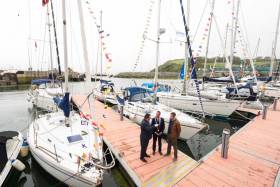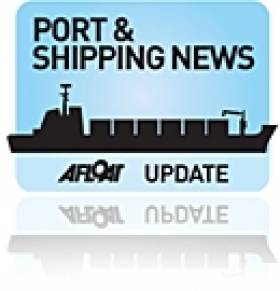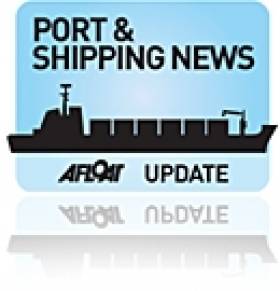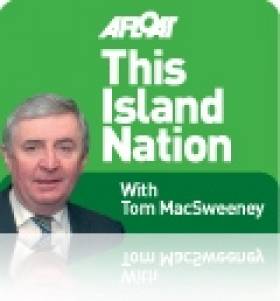Displaying items by tag: Bantry Harbour
Bantry Bay Port Company officially opened the new Bantry Harbour Marina yesterday (Friday, 11th August 2017). Over 40 boats visited the new marina which was officially unveiled by Bantry’s own footballing legend, Graham Canty along with Bantry Bay Port Company Chairman, John Mullins.
To celebrate the opening, Bantry Regatta and BBQ Festival is taking place all weekend (11th - 13th August) with lots of fun family events, both on and off the water happening on the marina and throughout Bantry town.
The opening of the new marina is part of the overall Bantry Inner Harbour Development which marks the start of the regenerating of the Inner Harbour Development scheme developed by the Bantry Bay Harbour Commissioners in 2012.
Speaking at the opening, Bantry Bay Port Company and Port of Cork Chairman John Mullins said “We are delighted that the new Bantry Harbour Marina is now open for local and visiting boats to enjoy. This new sheltered harbour facility will be of great benefit to both commercial and leisure users bringing increased activity in Bantry Harbour and Town and we would like to acknowledge the cooperation and patience of all local harbour users shown throughout the construction period.”
He continued, “We are pleased to have worked closely with the Bantry Development & Tourism Association and the Bantry Business Association to host the inaugural Bantry Regatta & BBQ Festival which is sure to be a fantastic weekend for all.”
Brendan Keating CEO Bantry Bay Port Company and Port of Cork said “I’d like to pay particular thanks to BAM Construction and Malachy Walsh Consulting Engineers and our own port teams in Bantry and in Cork.”
He continued, “The Inner Harbour Development will provide improved access and facilities on the town pier, will support existing businesses and will promote and increase commercial activity in Bantry Harbour and Town.”
Bantry Harbour Marina will provide 40 short-stay berths for the marine leisure sector in close proximity to Bantry Town which will provide a critical kick-start for the marine leisure industry, with the aim to attract more marine tourism to the area.
Bantry Harbour to Be Given €24m Redevelopment
#BantryHarbourPlans - The Port of Cork Company is to embark shortly on what it hopes will be the first phase of a €24m redevelopment by the port for facilities at Bantry Harbour which will encourage more seaborne trade and cruise line business.
The first phase of the plan will be a €7m upgrade of facilities at the town pier, which needs remedial work, and widening to accommodate buses which can meet tenders from cruise liners.
Denis Healy, the deputy chief executive of the Port of Cork, said that dredging would also take place to ensure that larger vessels could pull alongside it.
"We are also going to create an amenity area adjacent to the railway pier, and a new quay wall which will accommodate a 16-berth marina," said Mr Healy.
The Irish Examiner has more to report HERE.
Councillors Given 2016 Start Date for Bantry Harbour Redevelopment
#BantryHarbourPlans – According to the Southern Star newspaper, councillors during a recent western committee meeting in Cork, were given a date for the much-mooted ambitious plans for Bantry Harbour.
Plans for the multi-million euro re-development of the town's inner harbour were once more outlined to the members, including the detail that Phase One, which will cost up to €7m, will see the dredging of the inner harbour, improvements to the town pier, an amenity area, and the construction of pier side pontoons.
But the meeting heard that it could be almost two years – in 2016 – before the work gets underway.
Brendan Keating, CEO of the Port of Cork company, told councillors that the Phase One work was necessary to ensure that Bantry Bay will become a key regional port for the south west.
To read more of the plans, the newspaper has a report here.
Takeover of Bantry Harbour Board is of Serious Local Concern
#BantryTakeover – The Cork Port Authority which is to propose a takeover of the Bantry Harbour Board on 1 January is a 'retrograde step' and is a 'huge opportunity missed for the greater Bantry area', according to Senator Denis O'Donovan.
The Southern Star which has much more on this story, writes that the deal orchestrated by the Department of Transport, Tourism and Sport under Minister Leo Varadkar 'offers little for the future of Bantry Harbour', said the Bantry-based senator, who has been a long-time opponent of such a takeover.
Six Thousand Milk Bottles, Barryroe Oil Progress & What Ships Might Look Like in 2020
#thisislandnation – Six thousand milk bottles in Bantry's inner harbour, Barryroe Oil progress, what will ships look like in 2020, disappearing manta rays, a new book scheme for seafarers, emotion in Union Hall, and the future of navigation and visual aids. Read on for this week's Irish and world maritime news developments.
SIX THOUSAND HARBOUR MILK BOTTLES

Diarmaid Murphy Bantry Atlantic Challenge organiser with schoolchildrens images of the event
The schoolchildren of Bantry created an impressive sight in the town's inner harbour where they used 6,000 two-litre milk bottles to build a replica boat for the Atlantic Challenge. Their project underlined the community-wide support for the event which brought hundreds of young sailors to the town for the past week.
Diarmaid Murphy, who led the event's organisational team, told me that the townspeople would like to see the inner harbour developed.
"It has considerable potential for marine leisure. The Challenge is a great event and we have been involved with it since 1988, so there is strong community support for what has been achieved here and the benefits the event, including taking part at home and abroad which has benefited our young people. The event also highlighted the potential of the inner harbour for the town."
The increase of interest in the Bantry Longboats which are used for the event is good to see. There are plans to build a new boat in Tullamore, so perhaps the inland waterways and the Shannon may see a longboat afloat.
BARRYROE OIL PROSPECTS
Last week I wrote about holding a vial of Barryroe Oil in my hand, pictured here and this week Provident Resources confirmed reports that the find has strong prospects. Its announcement will increase interest by the 'majors' in oil production and this is normal at this stage of the find. What benefit will Ireland get from the find? That question has been raised. The present situation is that 25 per cent of the net profits of a developed find, but note that is 'net' after exploration and development costs have been deducted, go to the State. Taxation changes could only be implemented for new investment. Don't expect, at least for the present, that Ireland is going to become as rich a country as Norway!
THE SHIP OF 2020

Technology has made major changes in ship design and operations, but reliance on modern electronic aids and monitoring and control systems will place extra pressure on watchkeepers who will have to avoid complacency in depending upon instrumentation and ensure that the shipboard "man-machine" interface works.
That observation is made in the International Journal of the Nautical Institute, Seaways. The Institute is the professional body for mariners. Rod Short who is Executive Secretary of GlobalMET Limited, writes: "Technological development and its impact on ship operations will continue and probably accelerate. On-board operational roles will have an increased element of systems monitoring and on-board management roles will move towards the building of leadership and teamwork, in particular developing teamwork among multi-cultural crews who may have varying standards of education and training."
He maintains that it is likely that a new ship in the 2015-2020 period will be "extensively automated with extensive use of electro-technology for all critical operations and will be more efficient, more economical and more environmentally friendly."
EMOTION IN UNION HALL

Marine correspondent Tom MacSweeney on right who unveiled the commemoration plaque and officially opened Union Hall Memorial Garden on Sunday July 22nd. On left is Mr Paddy O'Donovan, MC for the occasion and founder of the local community council.
The community of Union Hall have built an impressive memorial to the memory of seafarers at the entrance to the village which was the centre of the Tit Bonhomme trawler tragedy search last January. It is dominated by a 23ft. high anchor.
"On the plaques are recorded the drowning of 99 people, 76 who are named and the majority of whom came from three parishes around Union Hall," community leader Paddy O'Donovan told me. "The other 23 are unknown to us but would have been either Italian or English."
Some lost their lives while earning their living in fishing boats, others drowned in foreign waters in both World Wars, some were strangers whose cargo ships foundered off the coast, others drowned while engaging in watersports. The earliest tragedies recorded date back to February 1874. The memorial has been part-funded by Cork County Council, the rest raised by the community, many of whom I met, including relatives of those who died in the tragedy and the only Egyptian survivor, when I was honoured to unveil the memorial.
BOOK SCHEME FOR SEAFARERS
The Marine Society of the UK has launched a new crew book service for seafarers and ship operators. Books@Sea will equip ships with new paperbacks for seafarers. It is a new crew library service built on the experience gained by the Marine Society over many years.
"It offers a means of relaxation for seafarers and is a positive contribution to a safety culture at sea," said Captain Andy Winbow, Assistant Secretary of the International Maritime Organisation, at the launching of the service in London.
More information on: www.marine-society.org
E-NAVIGATION DEVELOPMENT
The Commissioners of Irish Lights will be working with user groups and stakeholders in the coming year to define how e-Navigation should be implemented in Ireland.
Captain Robert McCabe, Acting Head of Marine at CIL, believes that the role of visual Aids to Navigation will "undoubtedly decrease and radio navigation will come to the fore." In The Beam magazine of the Commissioners he indicates that 'Visual AtoN will still have a role 'for spatial awareness and the marking of some dangers' but they will reduce in both number and range.
"The risks of 'heads down' navigation (looking at the screen) are obvious. The challenge is to significantly improve 'heads up' navigation (looking out the window) and to continue to engage navigators with their surroundings while taking advantage of improved positioning, communications and charting. In the coming year we will work closely with user groups and stakeholders to define how e-Navigation should be implemented in Ireland and how we can maximise the benefit."
GENTLE GIANTS UNDER THREAT
The ocean's "gentle giants" as they are known, manta rays, are under threat because of increased fishing in Asian and South American waters to catch and kill them for their gills, used in soups and other dishes in Asia and traditional Chinese medicine.
The rays are pulled from the ocean, using either fine gill nets or spears. They are easy targets as they move slowly through the water. The United Nations Food and Agriculture Organisation says catches have quadrupled and the International Conservation for Nature has now classified the species as 'vulnerable.' They are in particular danger because they produce few young.
You can follow me for more marine news and comment on Afloat's Twitter and Twitter: @TomMacSweeney
And on Facebook – Afloat magazine and This Island Nation


































































